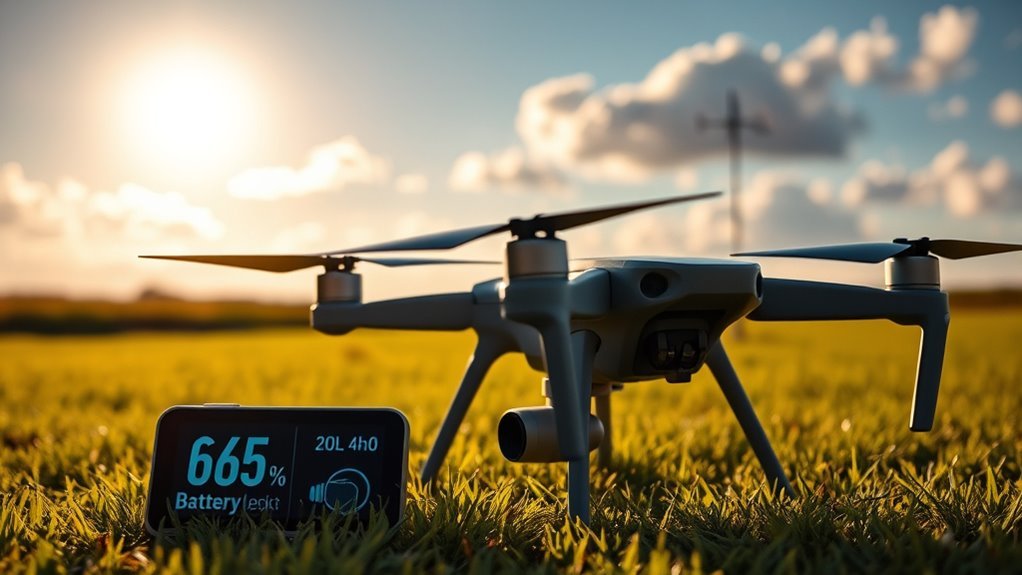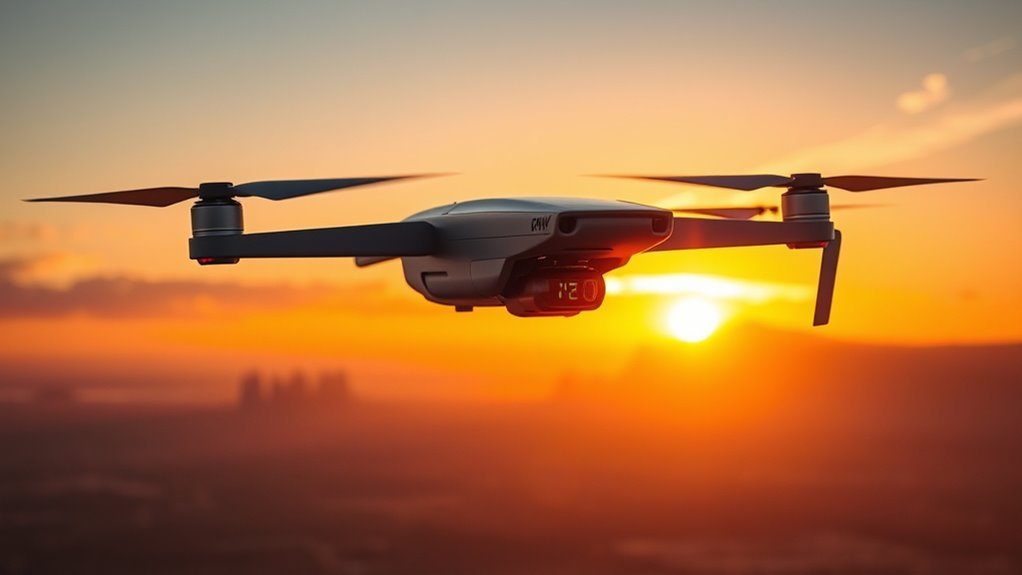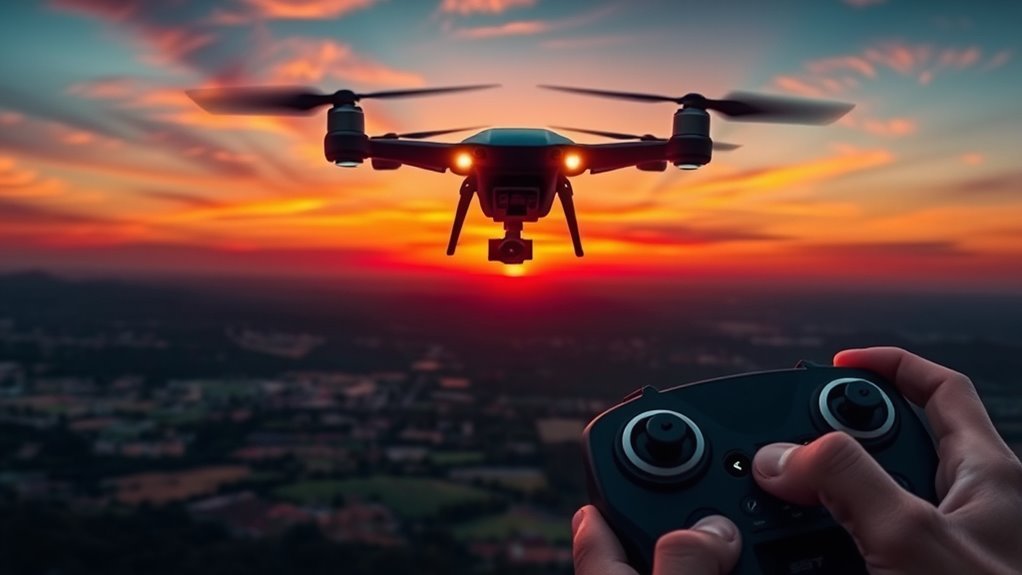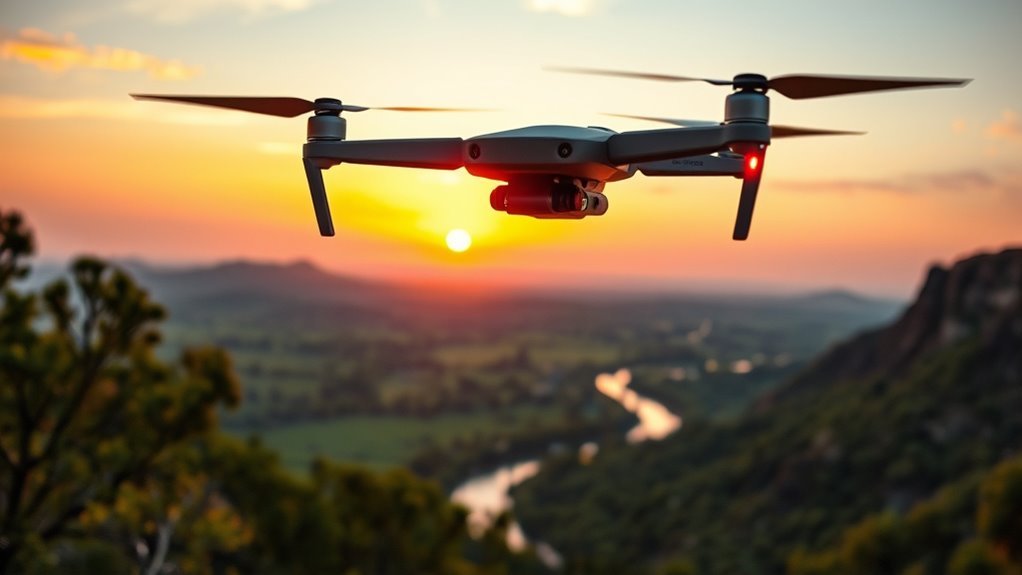Several factors determine how long your drone will fly. Battery capacity and type greatly impact flight duration, while weight distribution affects energy efficiency. Aerodynamics and propeller design play essential roles, as do your selected flight modes and power settings. Environmental conditions, like wind and humidity, also influence performance. Your piloting techniques can enhance or reduce efficiency. Understanding these elements will help optimize your drone’s flight time, allowing you to maximize its potential in the air.
Battery Capacity and Type

When considering drone flight duration, the battery capacity and type play essential roles in performance. Lithium polymer (LiPo) batteries are a popular choice due to their high energy density and lightweight design, which enhances your drone’s flight time. However, maintaining these batteries is important; improper care can lead to reduced capacity and lifespan. Regularly check for puffing, damage, and balance charging to optimize performance. Additionally, understand how different capacities influence your drone’s endurance. Higher capacity batteries provide longer flight times but can add weight, which ultimately affects flight efficiency. By prioritizing battery maintenance and selecting the right type, you can maximize your drone’s potential, granting you the freedom to explore the skies with confidence. Furthermore, understanding battery life differences aids in selecting appropriate drone types for your specific needs. The XG Neith Drone’s high-capacity lithium-polymer battery design ensures stable power output for extended flights.
Weight and Aerodynamics

When considering drone flight duration, the weight of the drone plays an essential role in its performance. Heavier drones require more energy to maintain flight, which directly affects battery life. Additionally, the efficiency of the drone’s aerodynamic design can either mitigate or exacerbate the impact of weight on overall flight time. Proper weight distribution is crucial, as it minimizes energy waste and optimizes motor efficiency for extended airtime. Drones like the Draganfly X4-ES utilize aerodynamic design enhancements to improve flight stability and energy efficiency.
Drone Weight Impact
Drone weight greatly influences flight duration, primarily through its effects on aerodynamics. Heavier drones require more energy to maintain lift, which can considerably reduce your flight time. The choice of drone materials plays an essential role in this equation. Lightweight materials can enhance overall efficiency, while poor weight distribution can decrease stability, further impacting performance.
- Ideal weight distribution enhances lift and control.
- Using advanced drone materials can reduce overall weight.
- Heavier drones struggle against wind resistance, affecting duration.
- Battery capacity must align with the drone’s weight for efficiency.
- Consider payload weight to maximize flight time and maneuverability.
Aerodynamic Design Efficiency
Aerodynamic design efficiency is vital for maximizing flight duration, as it directly influences how well a drone can navigate through the air. By utilizing aerodynamic shapes, you can greatly enhance performance and achieve effective drag reduction. A well-designed drone minimizes air resistance, allowing it to fly longer distances with less energy consumption.
When you’re considering the drone’s weight, remember that a lighter design often complements aerodynamic efficiency. Striking a balance between weight and aerodynamics is essential; if your drone is too heavy, it’ll require more power to maintain altitude and speed, reducing flight time. Ultimately, focusing on aerodynamic design not only optimizes speed but also extends flight duration, giving you the freedom to explore the skies longer.
Battery Capacity Considerations
Battery capacity plays an essential role in determining overall flight duration, as it directly impacts both weight and aerodynamics. A heavier battery can reduce flight efficiency, while a well-tuned capacity enhances performance. Here are some key considerations for maximizing your drone’s potential:
- Choose lightweight batteries to minimize weight.
- Regularly follow battery maintenance tips to extend lifespan.
- Implement efficient charging practices to guarantee peak performance.
- Balance battery capacity with desired flight time and drone weight.
- Monitor battery health to prevent failures during flights.
Flight Modes and Settings

Your choice of flight mode profoundly influences drone performance and battery life. Different power settings, along with adjustments in altitude and speed, can either extend or reduce flight duration. Understanding these factors is essential for optimizing your drone’s operational efficiency. Drones like the DJI Mavic 3 Enterprise utilize advanced technology to enhance flight time and efficiency compared to other models. For example, the advanced flight modes found in drones like the DJI Mavic Pro allow for tailored experiences that can impact overall battery consumption.
Flight Mode Selection
Though it may seem minor, selecting the appropriate flight mode greatly influences a drone’s overall flight duration. Different flight modes come with their own advantages and disadvantages that can impact battery consumption and efficiency.
Consider the following factors when choosing a flight mode:
- Stability Mode: Offers easy control but may use more battery.
- Sport Mode: Provides agility and speed, but drains power quickly.
- GPS Mode: Enhances stability and accuracy, extending flight time.
- Follow Me Mode: Great for tracking, but can lead to faster battery depletion.
- Manual Mode: Grants freedom but requires skill and may reduce efficiency.
Understanding these flight mode advantages and disadvantages allows you to optimize your drone’s performance for longer flights.
Power Settings Impact
Power settings greatly impact drone flight duration, and selecting the right configuration can enhance efficiency. Effective power management is essential for maximizing energy efficiency, allowing you to extend flight times without sacrificing performance. Understanding the different power settings is key to optimizing your drone’s capabilities.
| Power Setting | Impact on Flight Duration |
|---|---|
| Eco Mode | Increases duration by 20% |
| Standard Mode | Balanced performance |
| Sport Mode | Reduces duration by 15% |
Altitude and Speed
While altitude and speed are essential factors in determining drone flight duration, their effects can vary greatly depending on the flight mode selected. Understanding how altitude effects and speed variations interact can help you optimize your drone’s performance.
- Higher altitudes may reduce battery efficiency due to colder temperatures.
- Increased speed leads to greater aerodynamic drag, consuming more power.
- Hovering consumes less power compared to sustained forward flight.
- Selecting ‘Sport’ mode can increase speed but reduces flight time markedly.
- Wind resistance at higher altitudes demands more energy, impacting overall duration.
Environmental Conditions
As environmental conditions fluctuate, they greatly influence a drone’s flight duration. Weather conditions, such as wind speed and precipitation, can notably impact your drone’s performance. High winds require more power to maintain stability, thereby reducing battery life. Additionally, low atmospheric pressure—often found at higher altitudes—can lead to decreased lift and efficiency, further shortening flight times. Humidity also plays a role; it can affect battery performance and the drone’s electronics. Understanding how battery capacity impacts flight duration is crucial for optimizing your drone’s range and guaranteeing a successful mission. When planning your flight, consider these factors to optimize your drone’s range and guarantee a successful mission. Understanding how environmental variables interact with your drone’s capabilities is essential for maximizing your aerial freedom and achieving your objectives. Furthermore, being aware of frequency bands can help you choose the most effective communication settings for your drone, particularly in challenging environmental conditions.
Drone Design and Technology
When it comes to maximizing flight duration, drone design and technology play essential roles that can’t be overlooked. The materials and innovations you choose directly impact performance and efficiency. With advancements in drone technology, manufacturers are continually improving designs to enhance flight times.
- Lightweight drone materials reduce energy consumption.
- Aerodynamic shapes minimize drag during flight.
- Battery technology advancements increase energy density, allowing for sophisticated algorithms that manage energy allocation based on payload weight and flight conditions.
- Advanced flight control systems optimize power usage.
- Modular designs allow for easy upgrades and repairs.
- For example, the battery performance of drones like the EXO Blackhawk 3 showcases how enhanced battery efficiency can greatly extend flight times.
Propeller Efficiency
Propeller efficiency is a critical factor influencing a drone’s flight duration. The design of your propellers directly affects thrust generation and overall performance. Selecting a suitable propeller involves balancing various parameters, such as diameter, pitch, and material. Understanding these can help maximize your drone’s flight time. Additionally, optimizing propeller efficiency can contribute to a proactive security posture, ensuring that every component of your drone operates effectively and minimizes unnecessary energy consumption. Furthermore, advanced battery technology, like that used in Draganfly Vital Intelligence, can significantly enhance the overall flight duration by optimizing power usage.
| Propeller Design Aspect | Impact on Efficiency |
|---|---|
| Diameter | Affects thrust; larger = more lift but higher drag. |
| Pitch | Determines speed; a higher pitch can increase speed but reduce efficiency at low speeds. |
| Material | Lightweight materials improve efficiency, while heavier materials may reduce flight time. |
| Blade Shape | Aerodynamic shapes enhance lift and reduce drag, improving overall performance. |
Pilot Experience and Techniques
While the technical specifications of a drone are essential, pilot experience and techniques greatly influence flight duration. Your ability to manage the drone effectively can maximize its flying time. Proper pilot training equips you with skills to enhance battery usage and control during flight. Here are some key factors to reflect on:
- Throttle management: Smooth throttle use conserves battery.
- Altitude control: Flying at ideal altitudes reduces drag.
- Wind awareness: Adjusting for wind conditions enhances stability.
- Flight patterns: Efficient routing minimizes unnecessary distance. Additionally, understanding battery efficiency can help you choose optimal conditions for longer flight times.
- Regular practice: Mastering flying techniques leads to better performance. Lucid Cleaning Drone’s advanced flight stability ensures smoother maneuvers in challenging environments, maximizing productivity for low-light operations.
Frequently Asked Questions
How Does Drone Maintenance Affect Flight Duration?
Drone maintenance greatly impacts flight duration. Regular drone inspections and adherence to maintenance schedules guarantee peak performance, preventing unexpected failures and maximizing battery efficiency, ultimately allowing you to enjoy longer, uninterrupted flights in the sky.
What Is the Impact of Payload on Flight Time?
Did you know that a drone’s flight efficiency can decrease by up to 30% with just an additional pound of payload weight? Balancing payload and performance is essential for maximizing your drone’s flight time and capabilities.
Can Software Updates Improve Flight Efficiency?
Yes, software enhancements can considerably improve flight efficiency. By optimizing flight algorithms, you can maximize energy usage, extend operational range, and enhance overall performance, allowing your drone to achieve its full potential in diverse conditions.
How Does Battery Age Influence Performance?
You’d think a battery’s lifespan is just a number, but it’s more like a ticking time bomb. As it ages, you’ll notice voltage drops, severely impacting your drone’s performance and flight duration. Embrace efficiency!
Are There Specific Regulations Influencing Drone Flight Times?
Yes, specific regulations can influence drone flight times. You’ll need to guarantee regulatory compliance within designated flight zones, as restrictions on altitude and airspace can affect how long your drone can operate safely and efficiently.

